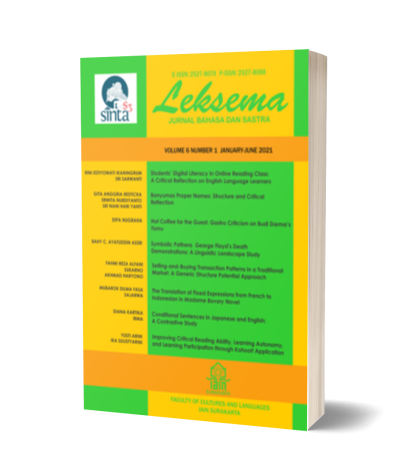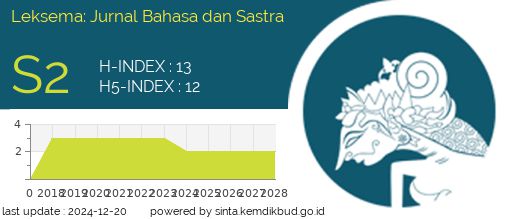TECHNIQUES AND QUALITY OF 'CIVIL WAR: WHOSE SIDE ARE YOU ON?' COMIC TRANSLATION
DOI:
https://doi.org/10.22515/ljbs.v3i2.1374Keywords:
translation, translation technique, translation quality, comicAbstract
The objectives of this study were to know the translation techniques and the assessment translation quality of Marvel comic series entitled Civil War: Whose Side Are You? (Part 1 and 2) in terms of accuracy, acceptability, and readability. This was a descriptive qualitative research and focusing on a single case as well as holistic research involving documents, i.e: the original and the translation books as the objective data and informants who gave assesment on the quality of the translation. The techniques of collecting data were document analysis, questionnaire distribution, and focus grup discussion. Total sampling was applied in this research. The research findings show that there were 12 types of translation techniques applied by the translator, namely established equivalent, borrowing, variation, modulation, explication, discursive creation, literal translation, reduction, transposition, addition, adaptation, and implication. The impact of the application of those techniques toward the translation quality was good enough. The scores indicate that the translation has good quality in terms of accuracy, acceptability, and readability. It also shows that background of the translators influenced the techniques chosen.Downloads
References
Badudu, JS. 2003. Kamus Kata-kata Serapan Asing Dalam Bahasa Indonesia. Jakarta: Kompas
Bonnef, Marcel. 1998. Komik Indonesia. Jakarta: KPG
Gombrich, Ernst H. 1974. “The Visual Image†in David R Olson (ed.): Media and Symbols: The Forms of Expression, Communication and Education. Chicago: University of Chicago Press
Kress, G & T. van Leeuwen. 2002. “Colour as A Semiotic Mode: Notes for A Grammar of Colourâ€. Visual Communication. 1-27
Kress, G & T. van Leeuwen. 2006. Reading Images: The Grammar of Visual Design. London: Routledge
McCloud, Scott. 2008. Membuat Komik: Rahasia Bercerita dalam Komik, Manga, dan Novel Grafis. (Translator: Alpha Febrianto) Jakarta: Gramedia Pustaka Utama.
Molina, L & AH. Albir. 2002. “Translation Technique Revisited: A Dynamic and Functionalist Approach†in Meta, XLVII (4): 499-512
Nababan, MR. 2003. Teori Menerjemah Bahasa Inggris. Yogyakarta: Pustaka Pelajar
Nababan, MR. 2004. Translation Process, Practices, and Products of Professional Indonesian Translators. (Unpublished Dissertation). Wellington: Victoria University of Wellington
Nababan, Rudolf dkk. 2012. Pengembangan Model Penilaian Kualitas Terjemahan. Surakarta: Universitas Sebelas Maret
Robinson, D. 1997. Becoming a Translator: An Accelerated Course. London: Routledge.
Rota, Valerio. 2008. Aspects of Adaptation: The Translation of Comic Formats in Comic Translation. Manchester: St. Jerome Publishing
Santosa, R. 2010. Logika Wacana: Analisis Hubungan Konjungtif dengan Pendekatan Linguistik Sistemik Fungsional. Surakarta: UNS Press
Shuttleworth, Mark & Maira Cowie. 1997. Dictionary of Translation Studies. Manchester: St. Jerome Publishing
Sutopo, HB. 2002. Metodologi Penelitian Kualitatif: Dasar Teoridan Terapannya dalam Penelitian. Surakarta: Sebelas Maret University Press
Young, L. & Brigid Fitzgerald. 2008. Understanding Comics (Memahami Komik). (Translator: S. Kinanti). Jakarta: Kepustakaan Populer Gramedia.
Zanettin, Federico. 2004. “Comics in Translation Studies. An Overview and Suggestions for Research†in Traduction et Interculturalisme VIIe: Seminaire deTraduction Scientifique et Technique en Langue Portugaise. Lisbonne
Downloads
Published
Issue
Section
License
The copyright of the received article shall be assigned to the publisher of the journal. The intended copyright includes the right to publish the article in various forms (including reprints). The journal maintains the publishing rights to published articles.
In line with the license, the authors and users (readers or other researchers) are allowed to share and adapt the material only for non-commercial purposes. In addition, the material must be given appropriate credit, provided with a link to the license, and indicated if changes were made. If authors remix, transform or build upon the material, authors must distribute their contributions under the same license as the original.






